Family: Pamphiliidae
Family common name: web-spinning and leaf-rolling sawflies
Subfamily: Pamphiliinae
Tribe: Neurotomini
Genus: Neurotoma Konow, 1897
Subgenera: none
The Pamphiliidae are called the web-spinning and leaf-rolling sawflies because of larval shelter-building behavior (Goulet 1992Goulet 1992:
Goulet H. 1992. The genera and subgenera of the sawflies of Canada and Alaska: Hymenoptera. Symphyta. The insects and arachnids of Canada. Part 20. Agriculture Canada Publication.).
Neurotoma are web-spinners that spin silk while they feed. Adults are medium-sized, usually patterned, and often colorful. They feed on cherry, plum, peach, almond, and hawthorn trees in North America (Middlekauff 1958Middlekauff 1958:
Middlekauff WW. 1958. The North American sawflies of the genera Acantholyda , Cephalcia , and Neurotoma (Hymenoptera, Pamphiliidae). University of California Publications in Entomology 14 (2): 51-174.).
There are 22 described species worldwide restricted to the Northern Hemisphere. Five species occur in North America, including the introduced N. edwardi (Taeger et al. 2010Taeger et al. 2010:
Taeger A, Blank SM, and Liston AD. 2010. World Catalog of Symphyta (Hymenoptera). Zootaxa 2580: 1-1064.).
A key to North American species of Neurotoma is included in Middlekauff 1958Middlekauff 1958:
Middlekauff WW. 1958. The North American sawflies of the genera Acantholyda , Cephalcia , and Neurotoma (Hymenoptera, Pamphiliidae). University of California Publications in Entomology 14 (2): 51-174..
 from above slightly constricted, without two distinct faces, more or less evenly flat from the dorsum to the anterioranterior:
from above slightly constricted, without two distinct faces, more or less evenly flat from the dorsum to the anterioranterior: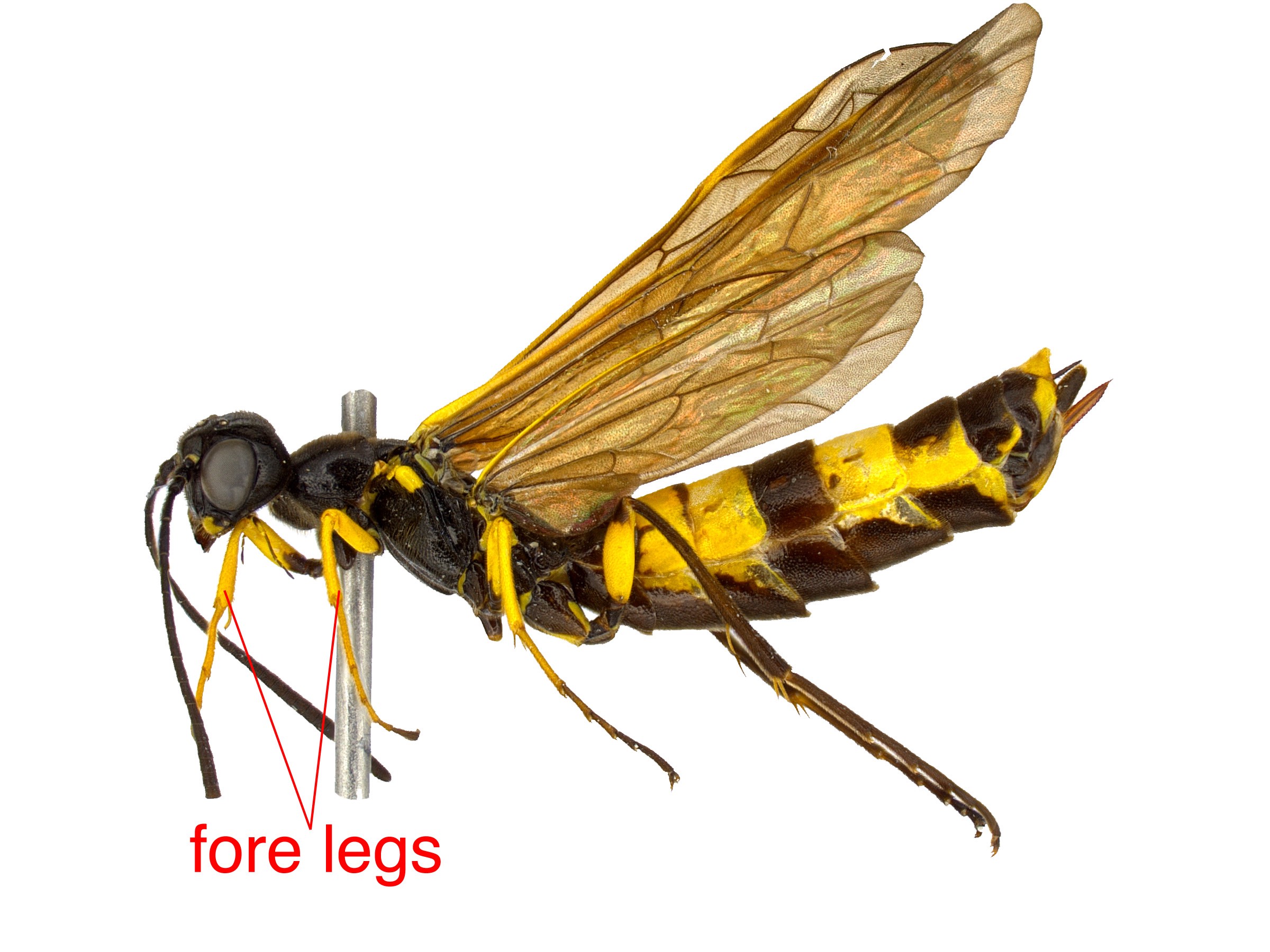 with 2 apicalapical:
with 2 apicalapical: with 3–4 preapicalpreapical:
with 3–4 preapicalpreapical: tibial spurs (Goulet 1992Goulet 1992:
tibial spurs (Goulet 1992Goulet 1992: width at basebase:
width at basebase: with large inner tooth; bifidbifid:
with large inner tooth; bifidbifid: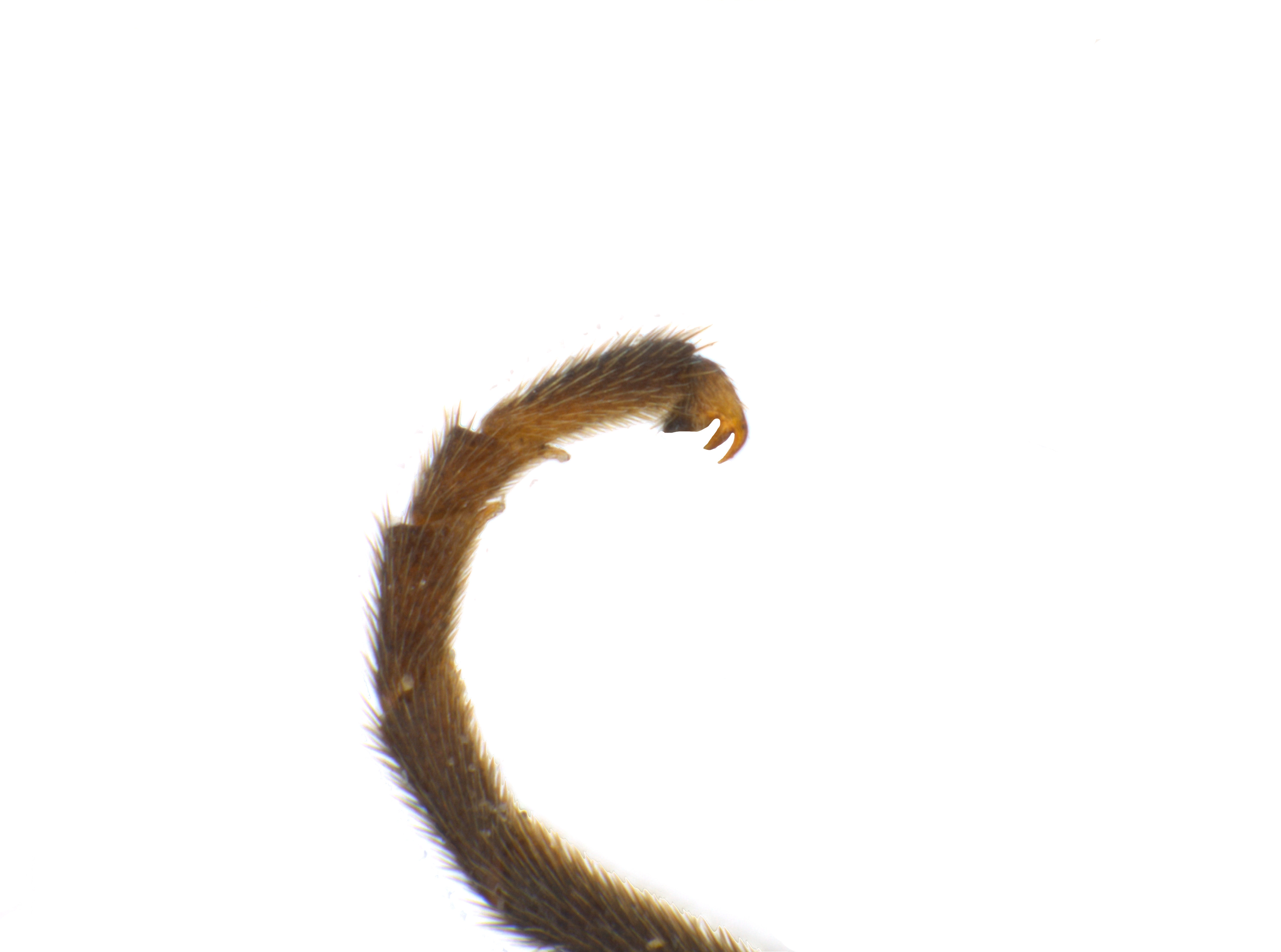 (Middlekauff 1958Middlekauff 1958:
(Middlekauff 1958Middlekauff 1958: membrane wrinkled horizontally at the apexapex:
membrane wrinkled horizontally at the apexapex: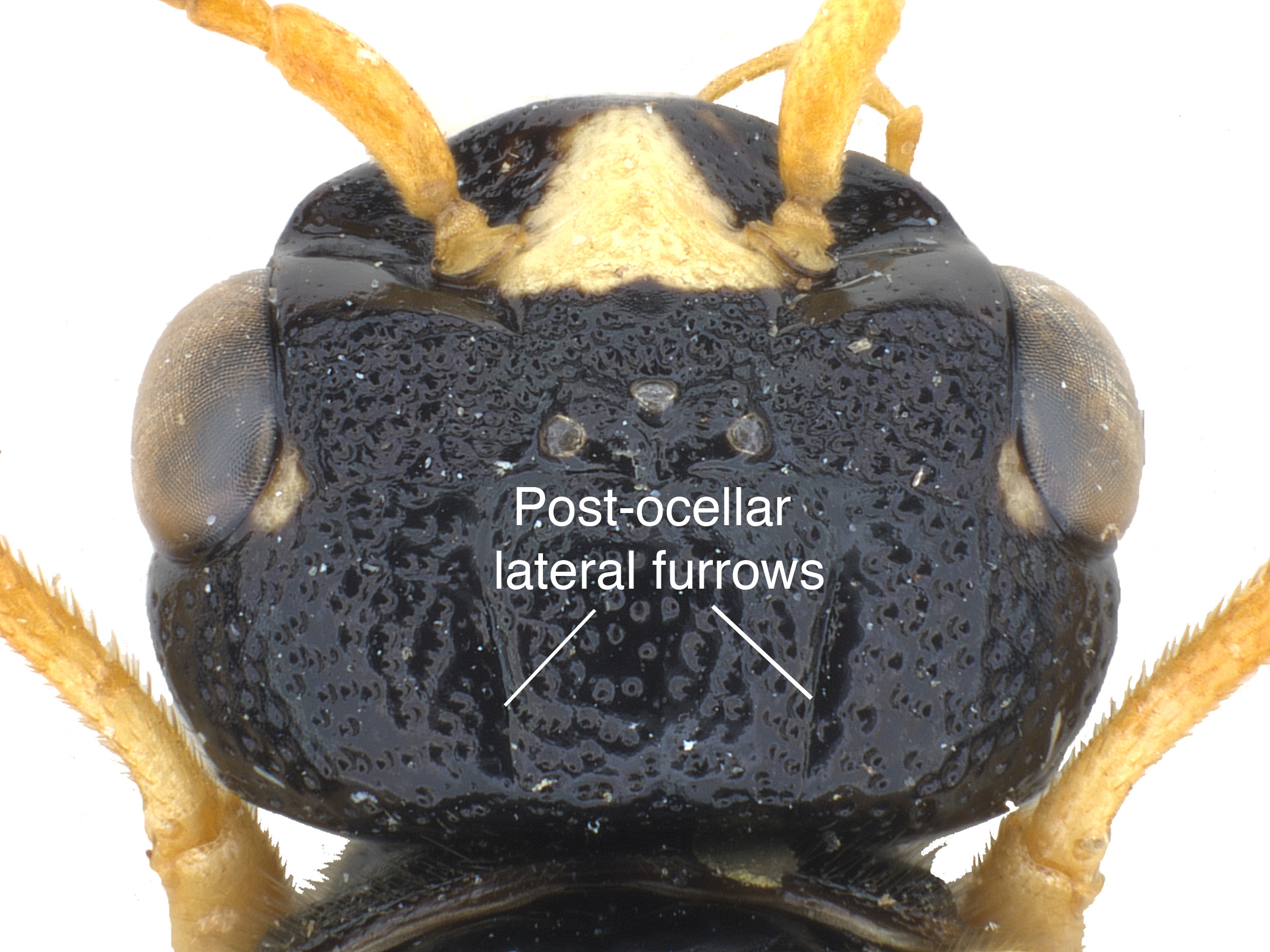 behind the compound eye weakly outlined (Goulet 1992Goulet 1992:
behind the compound eye weakly outlined (Goulet 1992Goulet 1992: stigma broad (Goulet 1992Goulet 1992:
stigma broad (Goulet 1992Goulet 1992: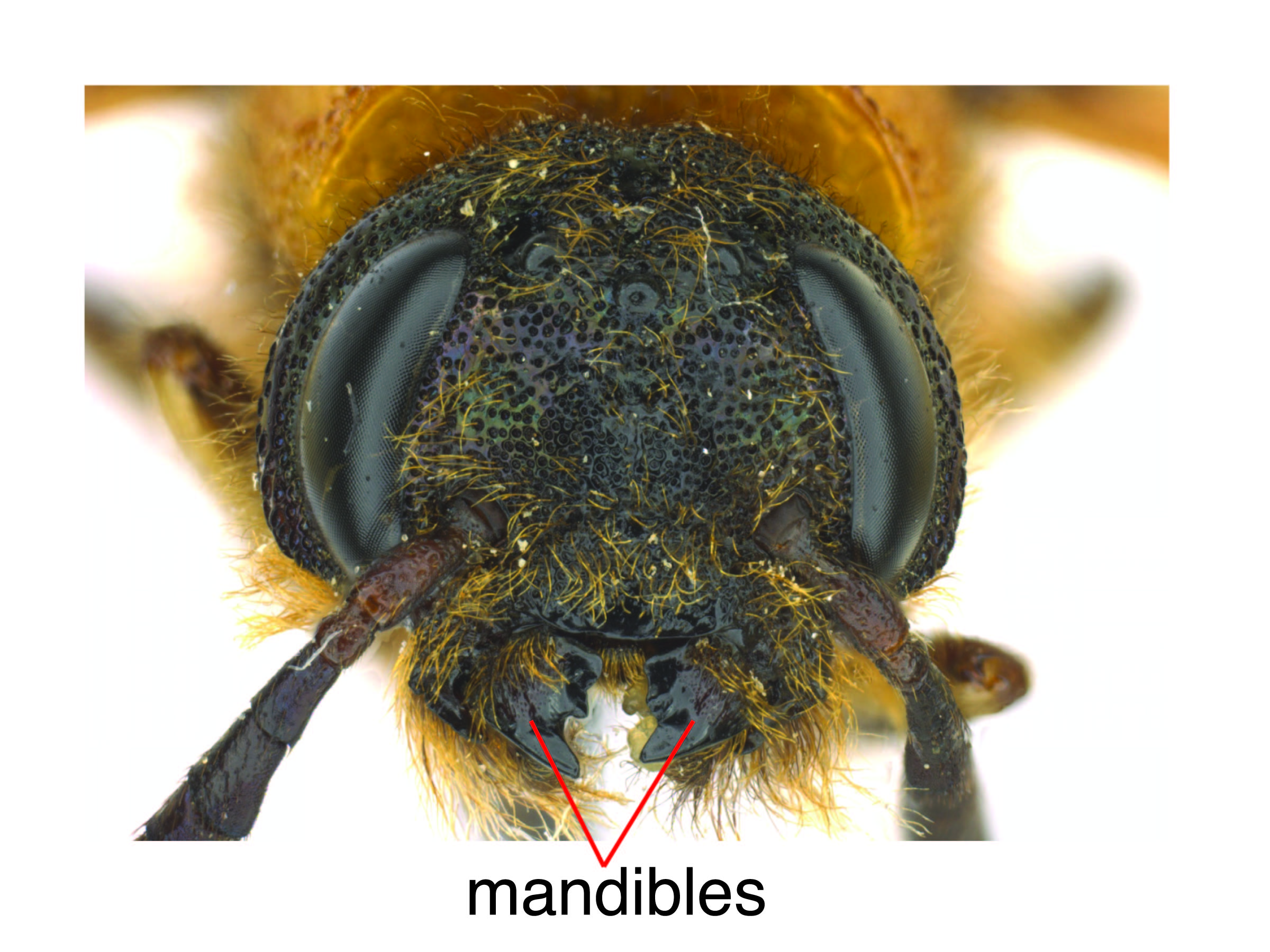 broad with 2 small inner teeth (Middlekauff 1958Middlekauff 1958:
broad with 2 small inner teeth (Middlekauff 1958Middlekauff 1958: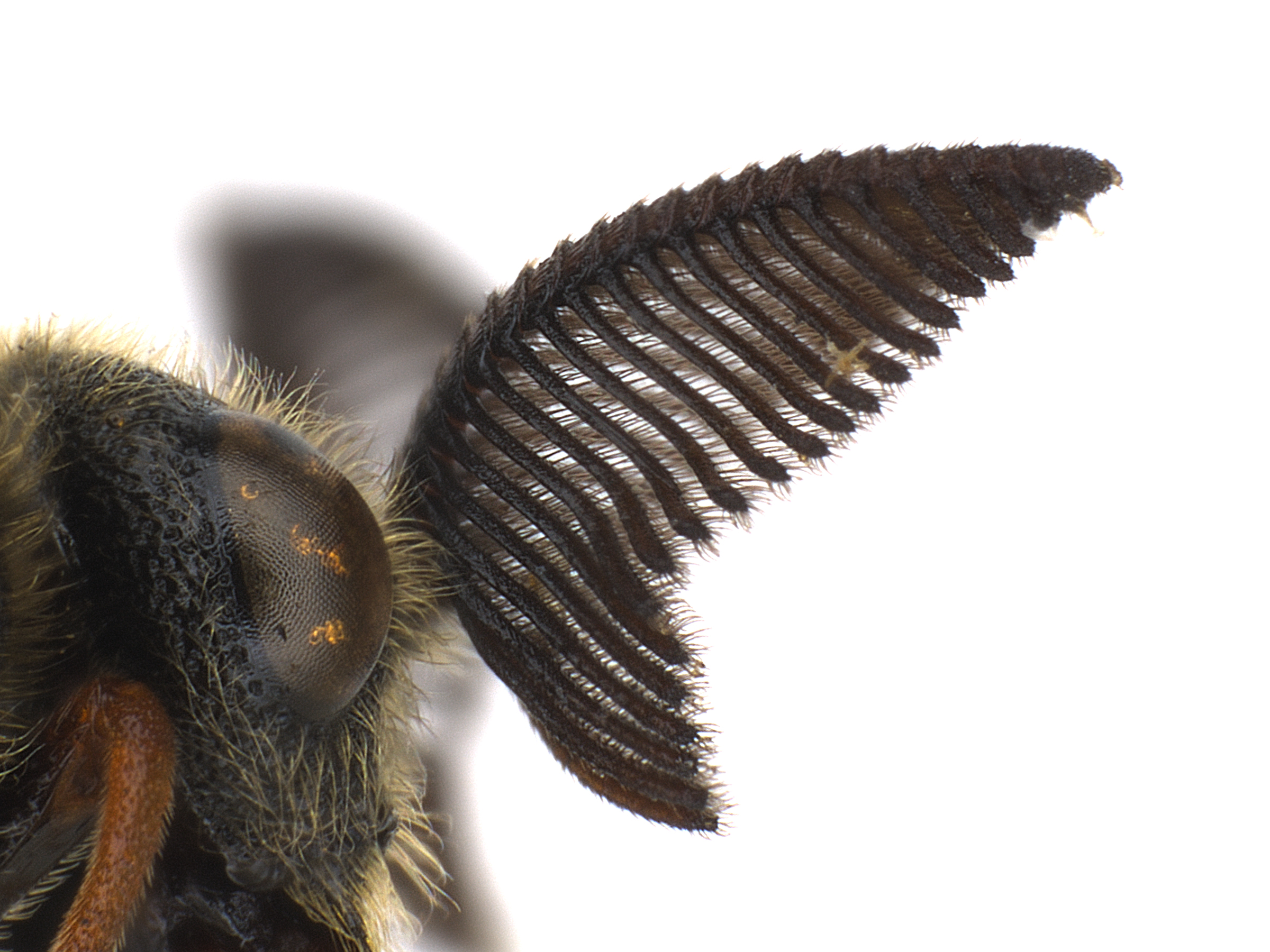 tibial spurs (Middlekauff 1958Middlekauff 1958:
tibial spurs (Middlekauff 1958Middlekauff 1958:Pamphiliidae are recognized by a somewhat quadratequadrate:
square-like or cube-like in shape
 head and tarsal claws with inner teeth. Neurotoma can be distinguished from Pamphilius and Onycholyda by the lack of fore wingfore wing:
head and tarsal claws with inner teeth. Neurotoma can be distinguished from Pamphilius and Onycholyda by the lack of fore wingfore wing:
the anterior wing of each pair of wings; usually the largest wing of the pair
 vein Sc1 and the laterallateral:
vein Sc1 and the laterallateral:
of or towards the side of the body
ocellar furrowfurrow:
a groove or linear depression
 , and from other genera in the family by the obviously bifidbifid:
, and from other genera in the family by the obviously bifidbifid:
divided or forked into two branches or parts
 claw, in contrast to a small inner tooth (Goulet 1992Goulet 1992:
claw, in contrast to a small inner tooth (Goulet 1992Goulet 1992:
Goulet H. 1992. The genera and subgenera of the sawflies of Canada and Alaska: Hymenoptera. Symphyta. The insects and arachnids of Canada. Part 20. Agriculture Canada Publication.).
One Japanese species, N. harai, is unique in that it feeds on Quercus sp. (oak) trees rather than Rosaceae. It is not generally considered a pest in its native range (Shinohara et al. 2018Shinohara et al. 2018:
Shinohara A, Choi JK, and Lee JW. 2018. The web-spinning sawfly genus Neurotoma (Hymenoptera, Pamphiliidae) of South Korea: Nuerotoma silla sp. nov. and a key to species. Zootaxa 4444 (5): 593-599. https://doi.org/10.11646/zootaxa.4444.5.7).
Larvae feed on plants of the family Rosaceae, including Prunus serotina (black cherry), P. pennsylvanica (pin cherry), P. americana (American plum), P. domestica (European plum), P. nigra (Canada plum), P. besseyi (sand cherry), P. cerasus (sour cherry), P. tenella (dwarf Russian almond), P. davidiana (Chinese wild peach), Crataegus succulenta (fleshy hawthorn) and C. brainerdi (Brainerd’s hawthorn) (Middlekauff 1958Middlekauff 1958:
Middlekauff WW. 1958. The North American sawflies of the genera Acantholyda , Cephalcia , and Neurotoma (Hymenoptera, Pamphiliidae). University of California Publications in Entomology 14 (2): 51-174.).
Females insert eggs singly or in groups on the underside of leaves alongside a veinvein:
a tube-like, often darkened, structure on the wings
 . Eggs are long and white/gray. After hatching, larvaelarva:
. Eggs are long and white/gray. After hatching, larvaelarva:
the immature stage of holometabolous insects
 spin webs of silk, frassfrass:
spin webs of silk, frassfrass:
solid larval excrement
, and leaf matter in which they feed, safe from predators. Some species feed gregariously, others singly in small individual webs on flower buds or leaves. Mature larvaelarva:
the immature stage of holometabolous insects
 fall to the ground and burrow into the soil where they overwinter. Pupation and emergence occur in the spring. Neurotoma is generally univoltineunivoltine:
fall to the ground and burrow into the soil where they overwinter. Pupation and emergence occur in the spring. Neurotoma is generally univoltineunivoltine:
describing an insect with a life cycle of one generation per year
(Middlekauff 1958Middlekauff 1958:
Middlekauff WW. 1958. The North American sawflies of the genera Acantholyda , Cephalcia , and Neurotoma (Hymenoptera, Pamphiliidae). University of California Publications in Entomology 14 (2): 51-174.).
Neurotoma inconspicua is commonly called the plum web-spinning sawfly and was recorded as a pest in the early twentieth century. Gregariousgregarious:
describing insects in large groups or aggregations
larvae feed in groups of as many as 46 at a time, sometimes seriously damaging Prunus (cherry, plum) crops in the Midwest (Severin 1920Severin 1920:
Severin HC. 1920. The plum web-spinning sawfly. South Dakota State Entomologist Bulletin 1: 1-53.).
World: Neurotoma is known from Europe, including east through Russia and in East Asia, including Japan, Korea, China, and as far south as Thailand (Middlekauff 1988Middlekauff 1988:
Middlekauff WW. 1988. A new species of Neurotoma from Michigan (Hymenoptera: Symphyta, Pamphiliidae). Pan-Pacific Entomologist 64 (3): 270-274., Taeger et al. 2010Taeger et al. 2010:
Taeger A, Blank SM, and Liston AD. 2010. World Catalog of Symphyta (Hymenoptera). Zootaxa 2580: 1-1064., Shinohara et al. 2018Shinohara et al. 2018:
Shinohara A, Choi JK, and Lee JW. 2018. The web-spinning sawfly genus Neurotoma (Hymenoptera, Pamphiliidae) of South Korea: Nuerotoma silla sp. nov. and a key to species. Zootaxa 4444 (5): 593-599. https://doi.org/10.11646/zootaxa.4444.5.7).
North America: In North America, Neurotoma is found in the Northeast and Midwest United States and eastern Canada, as far west as eastern British Columbia in the north, and as far south as Virginia in the east (Middlekauff 1958Middlekauff 1958:
Middlekauff WW. 1958. The North American sawflies of the genera Acantholyda , Cephalcia , and Neurotoma (Hymenoptera, Pamphiliidae). University of California Publications in Entomology 14 (2): 51-174., Middlekauff 1988Middlekauff 1988:
Middlekauff WW. 1988. A new species of Neurotoma from Michigan (Hymenoptera: Symphyta, Pamphiliidae). Pan-Pacific Entomologist 64 (3): 270-274.).
Map data from: GBIF.org (26 June 2019) GBIF Occurrence Download Neurotoma
Details about data used for maps can be found here.